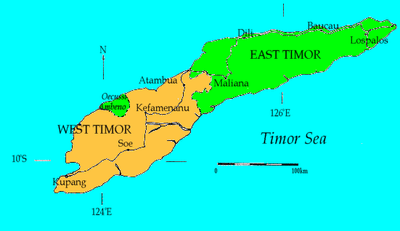West Timor

West Timor (Indonesian: Timor Barat) is the western and Indonesian portion of the island of Timor and part of the province of East Nusa Tenggara (Indonesian: Nusa Tenggara Timur).
During the colonial period it was known as Dutch Timor and was a centre of Dutch loyalists during the Indonesian National Revolution (1945–1949).[1][2]
From 1949 to 1975 it was known as Indonesian Timor.[3][4] Its name is an oxymoron in Indonesian: Timor means "East", thus the local name Timor Barat (West Timor) is literally "West East" (in Indonesian nouns come before the adjectives that modify them).
History

European colonization of Timor began in the 16th century. Although the Portuguese claimed the island of Timor in 1520, the Dutch (in the form of the Dutch East India Company) settled West Timor in 1640, forcing the Portuguese out to East Timor. The subsequent collapse of the company meant that in 1799, the area returned to official Dutch rule. Finally, in 1914, the border between East and West Timor was finalized by a treaty between Portugal and the Netherlands that was originally signed in 1859 and modified in 1893.
West Timor had the status of residentie within the Dutch East Indies.
Japan conquered the island during World War II in early 1942. Upon Indonesian independence, West Timor became part of the new Republic of Indonesia.
On 6 September 2000, Pero Simundza from Croatia, Carlos Caceres-Collazio from Puerto Rico and Samson Aregahegn from Ethiopia – all UNHCR staff members – were killed in an attack by 5,000 members of a pro-Indonesian militia, armed with machetes, on the office of UNHCR in the town of Atambua, which is in the vicinity of the border with East Timor and where the main refugee camp was located[5] (see attacks on humanitarian workers).

Geography

West Timor is a political region that comprises the western half of Timor island with the exception of Oecusse district (which is politically part of East Timor) and forms a part of the Indonesian province of Nusa Tenggara Timur (NTT, or East Nusa Tenggara). The land area of West Timor is 15,850 square kilometres (6,120 sq mi). The highest point of West Timor is Mount Mutis, at 2,427 metres (7,963 ft).
Rote Island, the southernmost island of Indonesia, is southwest of West Timor.
West Timor's largest town and chief port is Kupang, the capital of Nusa Tenggara Timur province.
Administration
West Timor is part of the East Nusa Tenggara province. It was formerly split into the City of Kupang (a kabupaten or regency-level administrative area) and four regencies (kabupaten); from west to east these are: Kupang, Timor Tengah Selatan (South Central Timor), Timor Tengah Utara (North Central Timor) and Belu. However, a fifth regency – Malaka – was in 2012 formed from the southern half of Belu Regency. Note the administrative area has shrunk as Rote Ndao Regency (Rote and Ndoa islands to the southwest) and Sabu Raijua Regency (the Savu Islands further west) were split off in 2002 and 2009 respectively from Kupang Regency. The island accounts for 35.5% of the provincial population.
| Name | Capital | Est. | Statute | Area (km²) | Population 2010 Census[6] |
|---|---|---|---|---|---|
| Kupang Regency | Kupang | 1958 | UU 69/1958 | 5,898.18 | 303,998 |
| South Central Timor Regency | Soe | 1958 | UU 69/1958 | 3,947.00 | 440,470 |
| North Central Timor Regency | Kefamenanu | 1958 | UU 69/1958 | 2,669.66 | 229,603 |
| Belu Regency | Atambua | 1958 | UU 69/1958 | 2,445.57 | 352,400 |
| Kupang City | * | 160.34 | 335,585 | ||
| West Timor | Kupang | 15,120.83 | 1,662,056 |
- Note that the figues for Belu Regency include those for Malaka Regency.
Population
There were approximately 1.8 million inhabitants in 2008, some of them refugees who had fled the 1999 violence in East Timor.
Languages
In addition to the national language, Indonesian, native languages belonging to the Fabronic Stock of the Austronesian group of languages are spoken in West Timor, the others in East Timor. These languages include Uab Meto, Tetum, Ndaonese, Rotinese and Helong.[7]
Knowledge of Dutch (the colonial language) is now limited to the older generations.
Religion
West Timor's main religions/faiths are Catholicism (56%), Protestantism (35%) and Islam (8%). From the Catholic missionary Apostolic Vicariate of Dutch Timor stem the Metropolitan Archdiocese of Kupang and its suffragan Diocese of Atambua.
Economy
West Timor has an average unemployment rate of 2.39%.[8] 30% of the population lived below the poverty line in 1998; as of 2012, it remained at 30%. The economy is mainly agricultural, using slash-and-burn methods to produce corn, rice, coffee, copra and fruit. Some timber harvesting is undertaken, producing eucalyptus, sandalwood, teak, bamboo and rosewood.
References
- ↑ Great Britain. Foreign Office. Historical Section (1920), Dutch Timor and the Lesser Sunda Islands, H.M.S.O, retrieved 17 January 2014
- ↑ Allied Forces. South West Pacific Area. Allied Geographical Section (1943), Area study of Dutch Timor, Netherlands East Indies, The Section, retrieved 17 January 2014
- ↑ "Political refugees 'flock' to Indonesian Timor.". The Canberra Times (ACT : 1926 - 1995). ACT: National Library of Australia. 25 February 1975. p. 1. Retrieved 17 January 2014.
- ↑ "10,000 waiting to go' to Indonesian Timor.". The Canberra Times (ACT : 1926 - 1995). ACT: National Library of Australia. 4 September 1975. p. 3. Retrieved 17 January 2014.
- ↑ http://www.unhcr.org/3fe17c9a4.html
- ↑ BPS Provinsi NTT
- ↑ West Timor Island
- ↑ http://ntt.bps.go.id
Coordinates: 10°23′S 123°38′E / 10.383°S 123.633°E